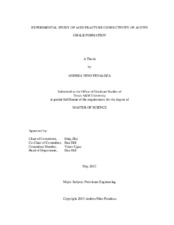| dc.description.abstract | Acid fracture conductivity and the effect of key variables in the etching process during acid fracturing can be assessed at the laboratory scale. This is accomplished by using an experimental apparatus that simulates acid injection fluxes comparable to those in actual acid fracture treatments. After acid etching, fracture conductivity is measured at different closure stresses.
This research work presents a systematic study to investigate the effect of temperature, rock-acid contact time and initial condition of the fracture surfaces on acid fracture conductivity in the Austin Chalk formation. While temperature and rock-acid contact are variables normally studied in fracture conductivity tests, the effect of the initial condition of the fracture surface has not been extensively investigated.
The experimental results showed that there is no significant difference in acid fracture conductivity at high closure stress using smooth or rough fracture surfaces. In addition, we analyzed the mechanisms of acid etching and resulting conductivity creation in the two types of fracture surfaces studied by using surface profiles. For smooth surfaces, the mechanism of conductivity creation seems connected to uneven etching of the rock and roughness generation. For rough surfaces, acid conductivity is related to smoothing and deepening of the initial features on the sample surface than by creating more roughness. Finally, we compared the experimental results with Nirode-Kruk correlation for acid fracture conductivity. | en |


